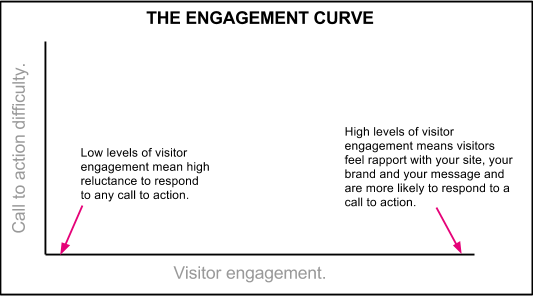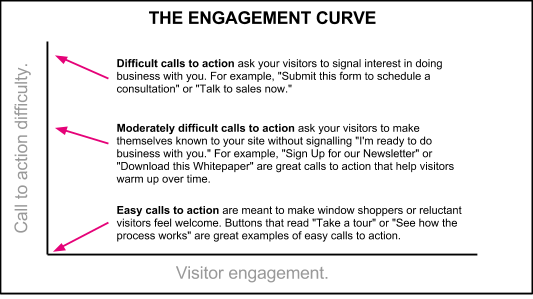
5 min read
Engagement Curve: How to Nurture Visitors into Leads
The Anatomy Of The Engagement Curve
We explain the concept of the Engagement Curve, and how this model can be used to optimize and increase website lead conversion.
Editor’s note: This piece was originally published in 2013. It’s been so popular that we decided to update it in 2019.
In any budding romance, the order of affection matters. For example, a handshake usually precedes a hug, a hug usually precedes a kiss, and a first successful date comes before committing to a second.
When it comes to the online experience, far too many websites go for a kiss on the first date, so to speak. Before sites even offer visitors a chance to become acquainted with who they are and what they have to offer, they pressure visitors to commit with pushy calls to action.
- Schedule a consultation!
- Sign up now!
- Purchase!
With just a little empathy and the help of the Engagement Curve, they could instead capture and retain website visitors’ attention for increased lead conversion. Once visitors are engaged, the likelihood of a rich and enduring courtship increases substantially.
The Engagement Curve
The practical concept behind the engagement curve is simple. The more engaged visitors are on your site, the more you can ask them to do. The two charts below illustrate how the engagement curve works to convert website visitors into customers in detail.
The X-axis shows a visitor’s level of engagement (from low to high)

The Y-axis illustrates the relative difficulty of what the site asks visitors to do (from easy to hard)

How To Convert Website Visitors Into Customers
Using the model of the engagement curve, there are some things your business can do to optimize your website and convert visitors into customers. These tips will help you get started:
Don’t Ask Visitors For Too Much, Too Soon
The problem with most sites is that the initial call to action asks for too much, too quickly. When a visitor lands on your site it’s likely they’ll have a high degree of reluctance to take any action right away. In otherwards, they are low on the engagement curve. Visitors that are low on the curve are far from subscribing to your newsletter or scheduling a sales call. The key is to warm them up, and to warm them up slowly.
Make Use Of The Scroll Bar
We frequently have clients ask about the scroll bar, and express concern about what is “above the fold” and “below the fold.” Forget the fold! By prioritizing all of your content above the fold, you dilute your message. If every piece of information is a priority, then nothing is really a priority. Scrolling down a page is a much easier action for a visitor to take than clicking on a button or link. Scrolling also allows visitors to stumble upon the content that hooks them, and to do so at their own pace.

Diversify Content Types
Different visitors will be drawn into your site by different types of content. As your visitors scroll down the page, reward them with engaging content. Include a variety of content, optimized for varying personalities and browsing styles. For example:
- For Kinesthetic Learners: Show a short video that connects on an emotional level
- For Analytical Types: Present an infographic packed with visual facts and figures
- For Interpersonal Realtors: Feature a few testimonials and success stories of how other customers have been successful
Capture Leads With Chunky Content
Once you have an engaged visitor, it’s time to entice them with a bit of chunky content. Chunky content refers to content that is immersive, exclusive and helpful. This content should solve a relevant and urgent problem for the reader. Whitepapers, e-books, and webinars are great examples of chunky content that assist in website lead conversion.
To effectively implement chunky content, you should develop artifacts for each major service or product area you plan to highlight on your site. For example, if your firm sells strategic advisory services and corporate financial planning, develop two whitepapers, one for each service area. Then place an attention-grabbing call to action (CTA) that presents the whitepaper, ensuring it includes a pain statement. Present this CTA on all related pages of your site.
When a visitor clicks on the CTA, direct them to a short, clean form that collects name and email and reasserts the value and urgency of the content they are about to receive. Once this identified lead is in your database, you can begin drip marketing. But remember to do so sparingly — revisiting our analogy above, you’ve only just gotten to the “second date!”
If you’re wondering how to convert website visitors into customers, the answer is the engagement curve. The engagement curve model offers some great lessons on how to optimize your site and engage visitors for website lead conversion. Want to learn more about how to ensure your customer’s love your product? Contact us to speak with one of our leading Product Design + Strategy experts.

Download the Ebook: Game Changers



Aw, this was a really nice post. Finding the time and actual
effort to generate a top notch article… but what
can I say… I hesitate a whole lot and never manage to get anything done.
Thanks for the kind comment! I know the feeling – it can be tough to find the time to capture and share lessons learned!
Hi there! This post couldn’t be written any better! Reading through this post reminds me of my previous room mate! He always kept talking about this. I will forward this article to him. Pretty sure he will have a good read. Thank you for sharing!
“Greetings! Very helpful advice within this post! It is the little changes which will make the greatest changes. Thanks for sharing!”